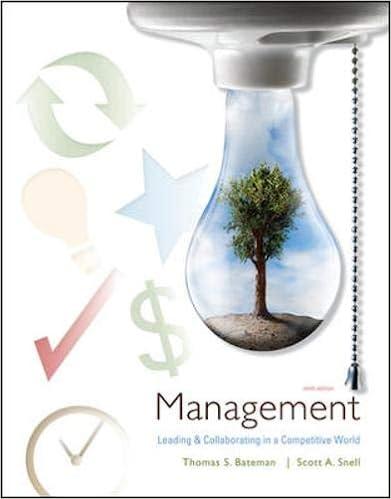Tyndall Red Wagon Inc. manufactures children's wagons. The wagons have a reputation for being sturdy and long lasting and have been popular with kids and
Tyndall Red Wagon Inc. manufactures children's wagons. The wagons have a reputation for being sturdy and long lasting and have been popular with kids and parents for decades. They are built with a solid wood deck, steel pull handles and axels, and 4 pneumatic 8-inch wheels. The quality of the wheels has attracted the attention of manufacturers in other industries such as trailer, lawn tractor, and wheelbarrow manufacturers. Management started the company as a small, two-person, centralized operation 40 years ago. Since then, the company has grown significantly and now employs more than 40 people and operates two manufacturing divisions: the Wheels Division and the Carriage Division.
Rob Tyndall, the original owner and CEO, is concerned about whether the company is as profitable as it could be as he prepares the company for a private sale to interested investors, as part of his plan to retire.
The Wheels Division produces the pneumatic wheels (on rims) that are used by the Carriage Division to complete each wagon to be sold. The divisions are organized as cost centres and, as such, managers in each division are responsible for cost control and rewarded accordingly. Bonuses are based on their ability to adhere to standard product costs and to investigate and address variances. The wagons are sold to retailers for $250 each.
The standard cost and operating assets data for each division are as follows:
Wheels Division (per wheel):
Direct materials $6.25
Direct labour 1.50
Variable overhead 0.90
*Fixed overhead 2.75 *Based on expected internal volume.
Operating assets 120,000
Carriage Division:
Wheels ?
Direct materials 85.00
Direct labour 25.00
Variable overhead 6.20
*Fixed overhead 18.00 *Based on expected internal volume
Operating assets 340,000
For many years, the Wheels Division had been operating in a building just large enough to provide space and capacity sufficient for the required production volume (5,000 units). However, in anticipation of continued growth, the company recently added on to the manufacturing space and purchased additional production equipment. This year, the Wheels Division expects to be producing at 60% of the new capacity (i.e., twice the previous capacity) to meet internal demand.
Currently, wheels are provided to the Carriage Division at full cost. At a recent industry conference, Rob met a purchasing manager from a wheelbarrow manufacturer who was familiar with Rob's product. The purchasing manager informed Rob that he is buying the same size wheel, but at a lesser quality, for his product at a price of $11 per wheel. Rob also attended a workshop at the conference that discussed the pros and cons of decentralized decision-making in firms. Rob has returned from the conference and has plans to pursue some new ideas.
Required:
1.As currently operated (i.e., centralized cost centres), would the manager of the Wheels Division be interested in investigating the potential for external sales?
2.At what price are wheels currently transferred to the Carriage Division?
3.If the Wheels Division was run as a profit centre and you were the manager, would you be interested in selling externally at a price of $11 per wheel? Calculate the ROI with and without external sales. (Assume the Wheels Division is able to produce to capacity and sell all of the output at $11.)
4.What recommendations would you provide to Rob in terms of how his company could be organized to motivate his division managers to seek opportunities that will enhance company profits?
5.Calculate residual income for Tyndall Red Wagon Inc., assuming corporate fixed costs are $60,000 and the Wheels Division is able to sell externally at $12.50 and use all of its production capacity. Assume also that the company begins using a transfer price policy based on market price, has a minimum return requirement of 12%, and that there are no beginning or ending inventories.
Step by Step Solution
There are 3 Steps involved in it
Step: 1

See step-by-step solutions with expert insights and AI powered tools for academic success
Step: 2

Step: 3

Ace Your Homework with AI
Get the answers you need in no time with our AI-driven, step-by-step assistance
Get Started


